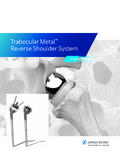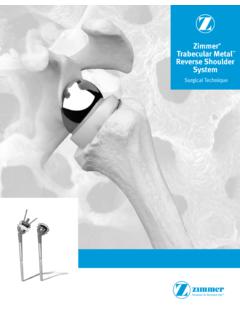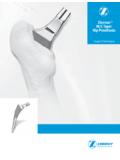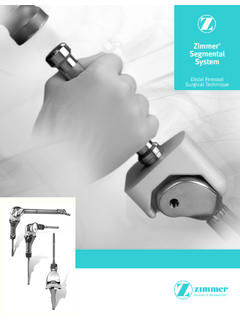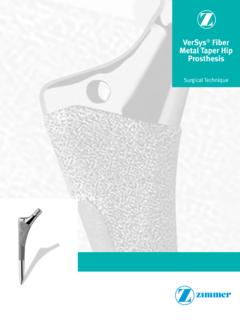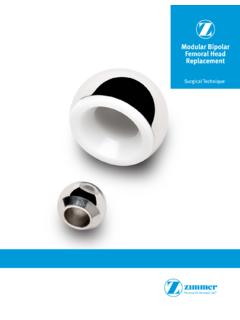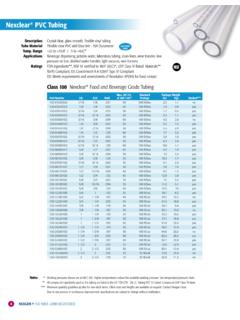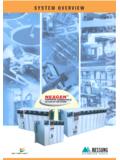Transcription of Zimmer NexGen RH Knee Primary/Revision
1 Zimmer NexGen RH knee primary /RevisionSurgical NexGen RH knee Primary/Revision Surgical TechniqueIntroductionThe NexGen Rotating Hinge knee (RH knee ) is designed for revision, difficult primary , and limb salvage surgeries in patients with significant bone loss and/or ligament deficiencies. Although most RH knee surgeries involve revision arthroplasty, this document provides options for all procedure types (Table 1). Revision: the RH knee is implanted using the NexGen Revision Instrumentation System, an intramedullary referencing system with all femoral and tibial cuts based from a reamer or Stem Extension Provisional located within the medullary canal. Difficult primary : the RH knee is implanted using either the NexGen Revision Instrumentation System or the Multi-Reference 4-in-1 Femoral Instrumentation System. Limb Salvage: The RH knee is also available for use in Proximal Tibial Replacements (PTR) in conjunction with the Zimmer Segmental System Trabecular Metal Proximal Tibial Component (Refer to the Segmental System Trabecular Metal Proximal Tibial Component Surgical Technique (97-5850-006-00)).
2 The Zimmer Segmental Distal Femur is also compatible with the RH knee Tibial Components (Refer to the Segmental System Distal Femoral Component Surgical Technique 97-5850-004-00).For all procedures, the tibial platform is established first because the tibial articular surface affects both the flexion and extension gaps, whereas the femoral component affects either the flexion or extension gap. The Zimmer Revision knee Arthroplasty Surgical Guidelines booklet 97-5224-003-00 is recommended for a more complete discussion on revision total knee arthroplasty technique. The RH knee prosthesis is constrained both mediolaterally and anteroposteriorly, but allows flexion/extension and rotation between the femoral and tibial components. To further accommodate the needs of each patient, the RH knee system is compatible with a wide variety of NexGen Revision implants and the Zimmer Segmental System (Table 2). Table. 1 Procedure ReferencesTable. 2RH knee Compatibility (Segmental Distal Femur Compatibility not shown)* Refer to the Segmental System Trabecular Metal Proximal Tibial Component Surgical Technique (97-5850-006-00)Option 3*Option 1 Option 2 ProcedureInstrumentationReferenceRevisio nNexGen Revision Instrumentation SystemMain BodyDifficult PrimaryRH knee InstrumentationAppendix BLCCK 4-in-1 Instrumentation Appendix CLimb Salvage (PTR)RH knee / LCCK 4-in-1 & Zimmer Segmental SystemAppendix DServicing the HingeRH knee & Zimmer Segmental System InstrumentationAppendix GComponentCompatibilityReferenceTibial ComponentRH knee Modular (Option 1) or non-Modular (Option 2) Tibial ComponentMain BodySegmental Trabecular Metal Proximal Tibial Component (Option 3)Appendix DArticular SurfaceRH knee Articular SurfaceMain BodySegmental Articular Surface (extended sizing options)Hinge PostRH knee Modular Hinge Post ExtensionMain BodySegmental One-piece Hinge Post (Back Table Assembly)
3 Appendix ESegmental One-piece Hinge Post (In vivo Assembly)Appendix FBone loss solutionsNexGen Augments & ConesMain BodySECTIONPAGE3 Step 3: Prepare Femoral Canal11 Step 3: Prepare Femoral Canal11 SECTIONPAGE7 Step 7: Establish Extension Gap & Stability16 Step 7: Establish Extension Gap & Evaluate Extension Balance Soft Reestablish Joint Line17 SECTIONPAGE6 Step 6: Establish Flexion Gap & Stability15 Step 6: Establish Flexion Gap & Stability15 SECTIONPAGE5 Step 5: Confirm Femoral Position & Establish Rotation 13 Step 5: Confirm Femoral Position & Establish Rotation Insert Femoral Provisional/Cutting Establish Femoral Rotation14 SECTIONPAGE11 Step 11: Perform Trial Reduction23 Step 11: Perform Trial Assemble & Insert Provisional Confirm Flexion/Extension Balance & Insert Hinge Post Extension Evaluate Patellar Tracking24 SECTIONPAGE12 Step 12: Implant Components25 Step 12: Implant Prepare Tibial Prepare Femoral Implant/Assemble Components27 SECTIONPAGE10 Step 10: Prepare Patella22 Step 10: Prepare Patella22 SECTIONPAGE9 Step 9: Prepare for RH knee Box19 Step 9: Prepare for RH knee Attach Notch/Chamfer Make the RH knee Box Cut 21 SECTIONPAGE8 Step 8: Make Femoral Augment Cuts18 Step 8: Make Femoral Augment Cuts18 SECTIONPAGE4 Step 4: Determine Femoral Size12 Step 4: Determine Femoral Size12 SECTIONPAGE2 Step 2: Finish Tibia5 Step 2: Finish Insert Tibial Sizing Prepare for Offset Prepare for Tibial Drill Stem Insert Trial Tibia Prosthesis10 SECTIONPAGE1 Revision Arthroplasty Using RH knee Instrumentation1 Step 1: Establish Tibial of ContentsTable of ContentsZimmer NexGen RH knee Primary/Revision Surgical TechniqueZimmer NexGen RH knee Primary/Revision Surgical TechniqueAPPENDIXPAGEAA ppendix A: Troubleshooting Flexion/Extension Gaps32 APPENDIXPAGEBA ppendix B.
4 primary Arthroplasty Using RH knee Instrumentation34 APPENDIXPAGECA ppendix C: primary Arthroplasty for RH knee Using NexGen LCCK 4-in-1 Instrumentation40 APPENDIXPAGEEA ppendix E: Using the One-piece Segmental Hinge Post with the RH knee Femoral Component (Back Table Assembly)59 APPENDIXPAGEFA ppendix F: Using the One-piece Segmental Hinge Post with the RH knee Femoral Component (in vivo Assembly)64 APPENDIXPAGEGA ppendix G: Servicing the Hinge of a Well Fixed RH Knee72 APPENDIXPAGEHA ppendix H: NexGen RH knee & Segmental Articular Surface/Hinge Kit Compatibilities86 APPENDIXPAGEDA ppendix D: Using the RH knee Femoral Component with the Segmental Proximal Tibial Component53 APPENDIXPAGEIA ppendix I: Augment Compatibility871 SECTIONSECTION112 InstrumentsInstrumentsRevision Arthroplasty Using RH knee Instrumentation8mm IM Step Drill00-5978-014-00 NexGen Reamer(See Profiler)00-5125-010-XXNexGen Reamer(See Profiler)00-5125-010-XXResection Line230mm175mm105mmFig.
5 4 Fig. 3 Revision Arthroplasty Using RH knee InstrumentationFig. 1 Fig. 2 TECHNIQUE TIP standard cutting slot on any of the Tibial Cutting Guides can be used for a flat cut. For a revision case, minimal bone removal is recommended. The purpose of this cut is to create a flat surface only. Revision Arthroplasty Using RH knee InstrumentationStep 1: Establish Tibial Platform If necessary, drill a starting hole with the 8mm IM Step Drill centered mediolaterally over the midpoint of the isthmus of the tibial canal. Beginning with the 9mm Intramedullary Reamer, progressively ream the tibial canal. Ream until cortical contact is achieved. Ream at least 1cm greater than the overall length of the selected components, burying the cutting flutes beneath the bone surface (Fig. 1).Warning: Because there is relatively little bone available in the tibia, perforation or fracture can occur with aggressive reaming. The final reamer or the stem provisional adaptor may be used for subsequent steps.
6 If all the reamer flutes cannot be buried in the bone, remove the reamer and insert the corresponding size Straight Stem Extension Provisional with the Stem Provisional Adapter attached (Fig. 3). If desired, remove the reamer and check alignment by using a Spacer Block with the Extramedullary Alignment Rod (Fig. 4). Attach the 0 Revision Tibial Boom to the reamer shaft (Fig. 5) or the Stem Extension Provisional : If the center of the tibial diaphysis and the center of the medullary canal do not coincide, an Offset Stem Extension is available. Reamer diameters start at 9mm and increase by 1mm increments up to 24mm. The reamers will ream line-to-line, ie, a 9mm reamer reams to a true 9mm diameter. When initially reaming the canal, ream based on the center of the canal. The largest reamer that can be completely buried for tibial preparation may be smaller than the reamer used to prepare for the final diameter and depth of the Stem Extension Provisional and implant.
7 Fig. 5 TECHNIQUE TIP help visualize reaming depth, lay the desired Tibial Provisional assembly next to the reamer and use a pen to mark the depth (Fig. 2). TECHNIQUE TIP external tibial landmarks to help ensure that the reamer remains in line with the tibial Rod with Coupler00-5785-080-000 Revision Tibial Boom00-5125-060-00 Spacer Block(See Profiler)00-5977-019-XXStraight Stem Extension Provisional(See Profiler)00-5989-010-XXStem Provisional Adapter00-5987-016-0075mm (30mm Actual Stem Length)200mm (155mm Actual Stem Length)145mm (100mm Actual Stem Length)1 SECTIONSECTION134 Fig. 6 Fig. 7 Fig. 8 Fig. 9 For a primary case, insert the 10mm tab of the Tibial Depth Resection Gauge into the cutting slot and check the depth with the probe at the lowest point on the condyle (Fig. 8). For a revision case, insert the 2mm tab of the Tibial Depth Resection Gauge into the cutting slot and check the depth with the probe as far back as possible on the defective condyle.
8 Slide the appropriate Tibial Cutting Guide (wedge or block) onto the Tibial Boom until it contacts the anterior tibia, and tighten the thumb screw (Fig. 6). Rotate the Tibial Boom so the Cutting Guide is oriented to achieve a direct front-to-back cut. Attach the Extramedullary Alignment Arch to the Tibial Boom, tighten the thumb screw, and insert the Alignment Rod with Coupler through the arch (Fig. 7). Confirm that the resected surface will be 90 to the tibial mechanical axis by ensuring that the Alignment Rod follows the anterior tibial crest, points about 7mm-10mm medial to the midpoint between the malleoli, and is in line with the tibialis anterior tendon. If the cut is not 90 , recut. Tighten the thumb screw on the Tibial Boom. Securely pin the Tibial Cutting Guide to the tibia with two Headless Holding Pins or Hex-head Screws. Use a in. ( ) oscillating saw blade to make the medial and lateral tibial cuts through the slots (Fig.)
9 9). Remove the reamer or provisional assembly, and the Tibial Boom, leaving the Tibial Cutting Guide in place. Finish the cut and remove the Cutting : Using the Hex-head Screws to secure the cutting guide to the bone will improve the stability of the TIP thinnest available RH knee Articular Surface is 12mm. For a primary case, the Tibial Depth Resection Gauge will allow only a 10mm resection. Therefore, lower the Tibial Cutting Guide an additional 2mm to remove the additional bone necessary to accommodate the thinnest articular Reamer(See Profiler)00-5125-010-XXNexGen Reamer(See Profiler)00-5125-010-XXStem Provisional Adapter00-5987-016-00 Stem Provisional Adapter00-5987-016-00 Tibial Cutting Guide(See Profiler)00-5987-015-00 (Wedge)Tibial Cutting Guide(See Profiler)00-5987-015-00 (Wedge)Alignment Rod with Coupler00-5785-080-00 Alignment Rod with Coupler00-5785-080-00 Straight Stem Extension Provisional(See Profiler)00-5989-010-XXStraight Stem Extension Provisional(See Profiler)
10 00-5989-010-XXExtramedullary Alignment Arch00-5125-081-00 Extramedullary Alignment Arch00-5125-081-00 Tibial Depth Resection Gauge00-5987-040-00 Tibial Depth Resection Gauge00-5987-040-00 Revision Arthroplasty Using RH knee InstrumentationRevision Arthroplasty Using RH knee Instrumentation0 Revision Tibial Boom00-5125-060-00 0 Revision Tibial Boom00-5125-060-00 Headless Holding Pins 00-522-039-00, 48mm00-5997-084-00, 75mmMIS Screw Inserter/Extractor00-5983-049-00 Hex-headed Screws00-5983-040-27, 27mm00-5983-040-33, 33mm00-5983-040-48, 48mmInstrumentsInstrumentsSECTIONSECTION 56 InstrumentsInstrumentsRH knee Distal FemoralSegmental Articular SurfaceRotating Hinge knee TibialRH knee Femoral SizeBCDEFRH knee Tibial Size1B/123456C/123456D/1234562B/123456C/ 123456D/123456E/234563B/123456C/123456D/ 123456E/23456F/34564B/123456C/123456D/12 3456E/23456F/34565B/123456C/123456D/1234 56E/23456F/34566B/123456C/123456D/123456 E/23456F/3456 Step 2: Finish Tibia22 Step 2: Finish TibiaTable.

